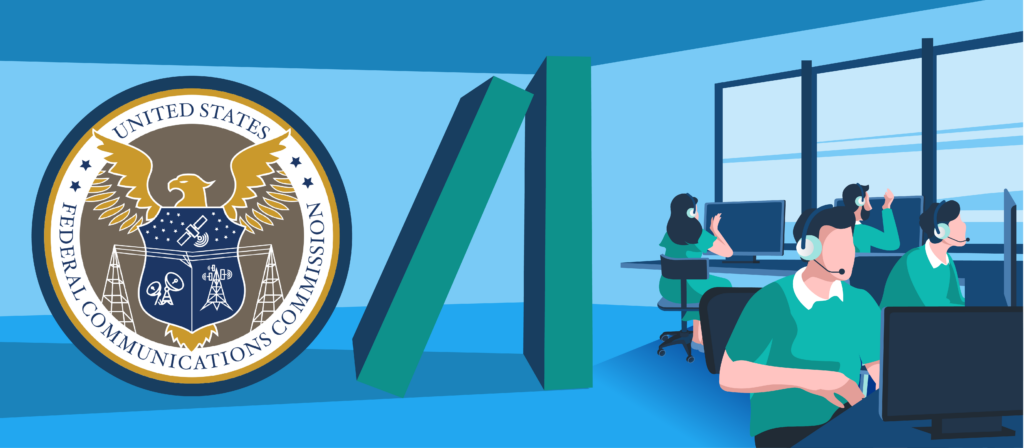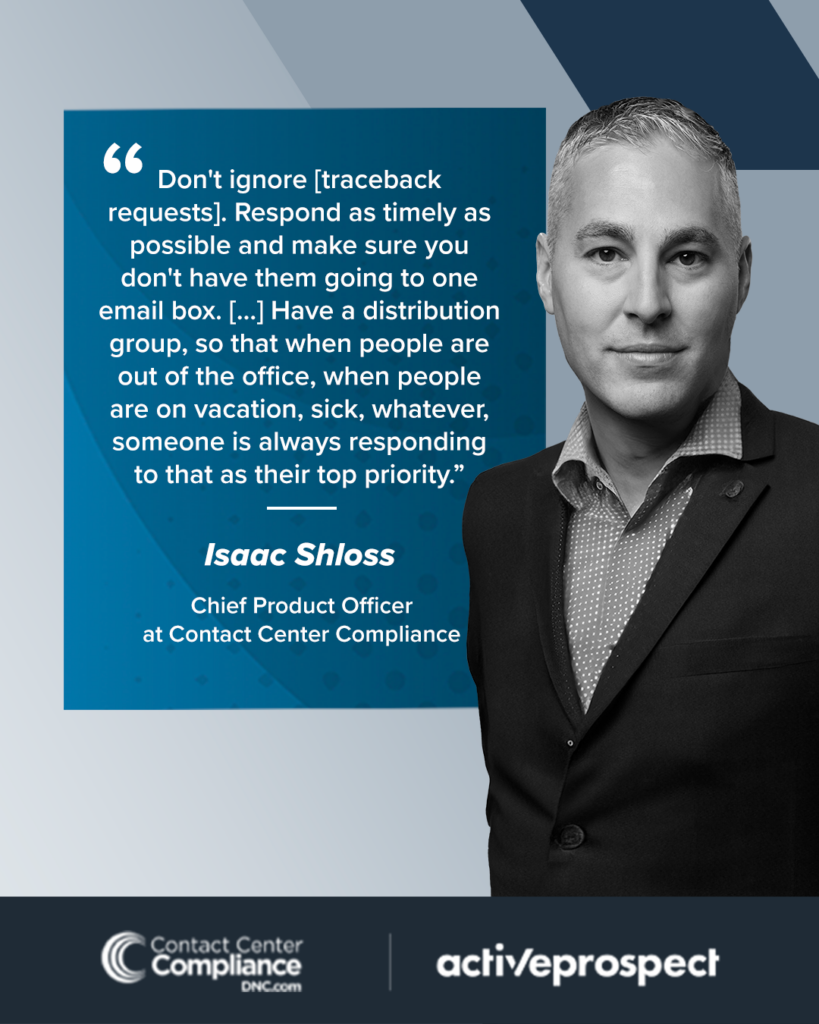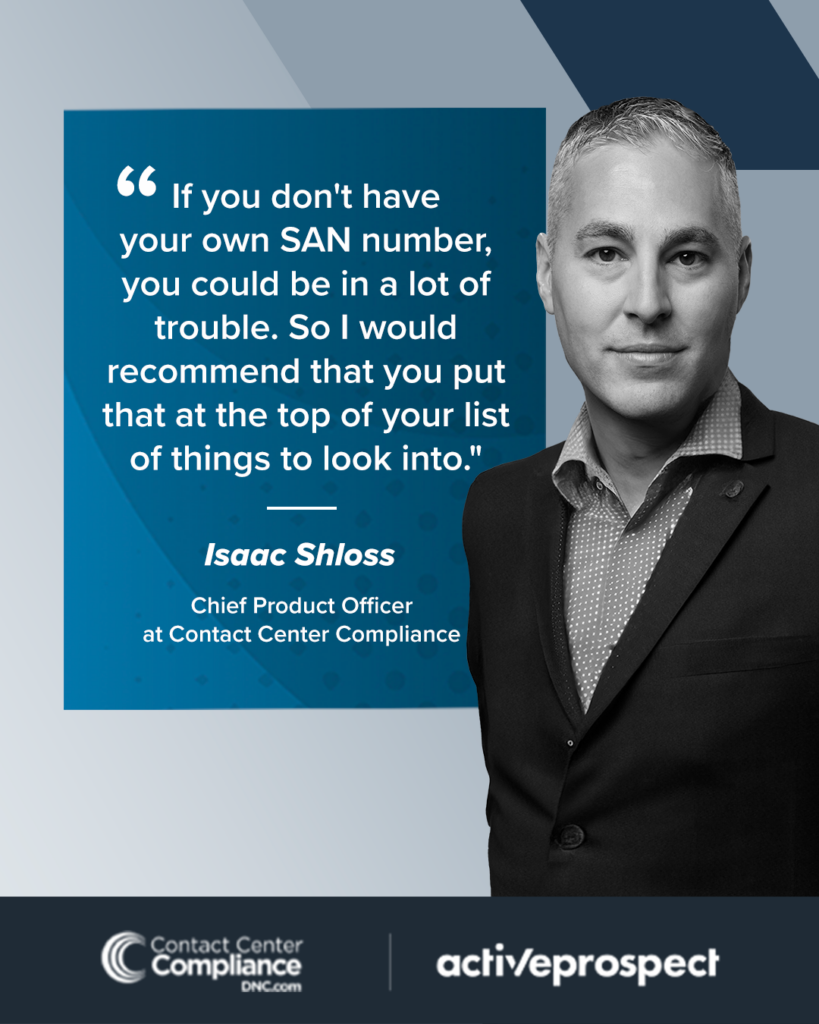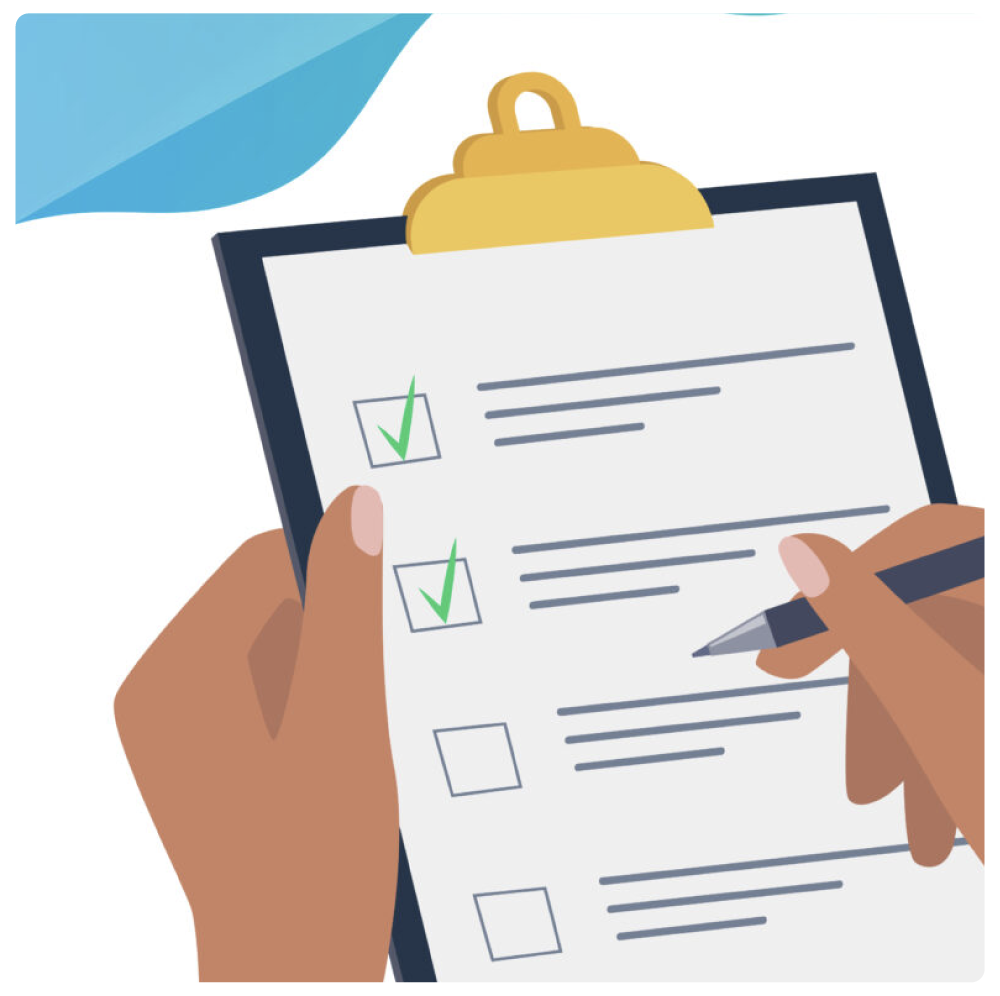Understanding how the latest FCC call center regulations are affecting businesses

In this episode of our FCC webinar series, “FCC Curveballs: TCPA compliance strategies for call centers,” our Director of Privacy, Security, and Compliance, Benjamin Farrar, had the opportunity to sit down with Isaac Shloss, Chief Product Officer at Contact Center Compliance, for an in-depth discussion about the implications of FCC call center regulations for brands that use automated dialing systems (ATDS) in light of the changes to TCPA guidelines.
Now, we would like to provide a clearer understanding of essential call center terminologies like call blocking, spam labeling, and tracebacks. We’ll break down each component, answer some key questions, and offer valuable insights and practical tips to help you confidently navigate the complex landscape of FCC call center regulations.
A review of call center terminology
According to Isaac Shloss, “call blocking” occurs when “carriers start filtering out calls that they don’t feel consumers want to get. […] The carriers can decide, you know what, this isn’t just spam. This isn’t just something that I don’t think that you want to hear. I think this is a bad actor. So I’m just gonna stop this call from getting through altogether. So that is what is commonly referred to as blocking, where they stop the call.”
As Isaac continues to explain, “labeling” is when carriers “label you as ‘spam’ or for some carriers you’ll even see ‘scam’ with a C put on there. And that’s troubling because it really just cripples your answer rates as a caller.”
Lastly, “tracebacks”. As Isaac explains, a traceback request “typically [occurs] when there’s some sort of official investigation trying to figure out whether or not you’re a bad actor.” Various triggers can initiate such investigations. Essentially, it’s the carriers’ obligation to provide information to the investigating agencies, commonly enforced by industry traceback groups, regarding the custody chain of a call.
For instance, I use Verizon for my mobile phone service on an Android device. However, receiving a call via Verizon does not necessarily imply Verizon is the call’s originator. The call may have been routed from AT&T to MCI, then to Windstream, and subsequently passed through several other companies. Traceback allows investigators to follow the call’s trail back to its source. This process is crucial, especially if there’s a need for enforcement actions, providing insight on the responsible party.
Should the call originate outside of the domestic sphere, investigators can identify the “gatekeeper” carrier that allowed entry into the U.S. system and confront them accordingly. It’s also worth noting that traceback inquiries can sometimes lead to the conclusion that there’s no fraudulent activity or wrongdoing, in which case the investigation is concluded with no further action.
Key questions about FCC call center regulations
Here are a few of the main FCC call center regulations questions that you should consider in order to stay compliant with the latest TCPA guidelines updates.
When a company is issued a traceback request, what’s the timeframe for submitting the requested information?
According to Isaac, “that window keeps shrinking.” The most recent update to the policy sets the timeframe at 24 hours. Isaac recommends promptly addressing that within a couple of hours to avoid any potential issues.

Ultimately, as Isaac advises, “time is of the essence and you know, any good attorney will tell you ‘always have yourself in a defensible position.’ So, things like cooperating with traceback requests tend to help.”
How are businesses classified as spam and how can they be reclassified?
As Isaac explains, “the way you get labeled as a spam…there’s a lot of different things that can lead to that. But one of the key points that can lead to that is calling into too many honey pots. […] Honey pots are systems designed to draw in a bad actor. Catch them, document them, and almost trap them in there.”
And when you get into that honeypot environment, regulators may perceive you as a possible non-compliant entity, which might trigger investigations.
Honeypots are essentially a collection of phone numbers (unlisted, unassigned, or at some point reassigned) that are not associated with any individual and used to document and identify companies that may be dialing phone numbers that are not in compliance with the TCPA or Telemarketing Sales Rule (TSR).
However, avoiding honeypots is pretty straightforward, according to Isaac. First, focus on reaching out to specific individuals. Second, avoid dialing numbers in a random or sequential pattern. Lastly, always verify the identity of the party you’re contacting and make sure the associated contact information matches the name and phone number of the lead who consented to be contacted.
4 key obligations to keep in mind for record-keeping requirements after the Telemarketing Sales Rule (TSR) recent updates
As explained by Isaac, “The TSR has made a lot of changes as well, and I’m gonna focus on four key points. And a lot of this has to do with how you’re scrubbing against the Do Not Call list.”
If you hold the necessary consent to contact someone, your concerns with the Do Not Call (DNC) registry may lessen. However, consent based on certain conditions, such as an Established Business Relationship (EBR), may not be indefinite. It’s critical to keep abreast of when such EBR consent might expire.
Should you be obliged to consult the DNC list, it’s imperative to meticulously record four essential pieces of information.
1. Document the name of the entity accessing the DNC registry
The term “entity,” often used in this context, requires clarification. Upon investigation, Isaac explains the term predominantly refers to the seller, though in some instances, it might encompass a company like Contact Center Compliance that administers DNC checks for their clients.
It’s advisable to track your activities as a buyer, especially when employing a third-party agency, such as a Business Process Outsourcing (BPO) call center, to administer or manage your calls. Make sure any third party conducting scrubbing on your behalf is also documented, and the same applies if you’re utilizing a service like DNC.com for DNC scrubbing simplification. When working with a BPO provider, it’s essential to outline clear expectations and responsibilities in the agreement. Understanding the key components of a BPO agreement ensures both parties are aligned on service standards and compliance requirements.
2. Document the exact date you checked the DNC registry
The reason it matters is straightforward: you could claim that the number wasn’t listed on the DNC list at the time of your check. However, if you last verified on February 1st and consumers registered on February 17th, and now it’s March 20th, you’re overdue for another check.
You have a 10-day window to confirm their inclusion on the DNC list and to respect consumers’ preferences. Therefore, it’s imperative to diligently record that date each time you access the registry.
3. Document the Subscription Account Number (SAN) you’re using
The Federal Trade Commission (FTC) has increased its focus on this area, and diligent adherence is paramount. It is essential for those involved in data scrubbing to assess their SAN number usage closely.
There are vendors claiming that a separate SAN number is unnecessary, offering to include it within their services. However, this practice is incorrect and not permissible under FTC regulations. Sharing a SAN number is explicitly prohibited, and operating without a distinct SAN number is a direct violation of the TSR. Any data scrubbed without an individual’s SAN number is deemed non-compliant by the FTC.
With potential investigations on the horizon, it’s critical to ensure you have a personal SAN number. Not having one could pose significant legal risks, so prioritize verifying your SAN status immediately.+

4. Document the specific campaign associated with your scrubbing initiative
When we speak of campaigns in a legal context, the term can take on various meanings. However, generally speaking, contacting a consumer for a new car sale and then later for a collections matter must be treated as distinct campaigns.
Careful tracking of these campaigns is crucial, as they might be subject to different regulations, particularly if one is for sales and marketing and the other for account or informational purposes. Keeping accurate records of these separate interactions is a wise practice, Isaac recommends you focus on.
Does the lead buyer or the lead seller need the SAN number?
As Isaac says, “Whoever’s buying the lead because they are selling a product or service, they need that SAN number.”
Very important note from Isaac: If you’re employing a third-party service to scrub your leads, it’s crucial that they use your specific SAN number – not their own – when scrubbing against the DNC list. For instance, if you instruct your lead provider to pre-screen numbers for DNC compliance, ensure they conduct the check with your SAN number, not theirs.
Remember, you can authorize external companies to use your SAN number for screening purposes as long as their efforts are aimed at helping you adhere to DNC regulations.
How do you access your SAN number?
As Isaac explains, a SAN number is issued directly by the FTC. To obtain one, you need to visit the FTC’s official website, register for a SAN, and be prepared to incur a fee. This fee varies depending on the quantity of area codes you intend to call into.
Keep in mind there’s a tipping point where it’s more cost-effective to opt for a national license over individual area code licenses.
If you use local presence, does the FCC or carrier consider that as call spoofing?
As Isaac explains: “Local presence is where you try to generate a caller ID on the caller’s phone or near the called party’s phone, that is similar to or in the same general area.”
In most cases – about 90% of the time – this practice is legal, provided you fulfill the requirement that allows individuals to call you back. They should be able to identify who’s calling, the reason for the call, and also have the option to request placement on your DNC list. You must have this system in place; without it, leveraging a local presence crosses into illegal territory.
It’s also worth noting that certain states have specific regulations regarding caller IDs. It’s crucial to stay aware of and respect these regional differences.
How carriers view the use of local caller IDs varies as well. Some are quite strict, viewing the practice with suspicion or equating it to spamming, particularly if toll-free numbers are involved. On the other hand, not all carriers see it this way; their policies can be nebulous.
Recent studies indicate that local presence still boosts response rates. While continuing to use this tactic is currently effective, staying informed and compliant with evolving laws and regulations is imperative. According to Isaac, there’s growing momentum behind efforts to restrict or even outlaw this practice, so adaptability is key.
How do you prove opt-in consent when someone opts out of the national DNC list?
As Isaac explains, “You’re going to need a well-attested lead form that shows that they provided consent. If you can prove you’ve got that lead form that shows they provided consent, then you are allowed to call them.”
Remember, consumers have the right to revoke that consent instantly – they might do so just five seconds after giving it. It’s essential to have an efficient process in place to respect these requests. Provided you gather proof of consent that an individual has agreed to be contacted, you’re allowed to call them, even if they are registered on the DNC list, until such consent is revoked.
TrustedForm helps you document the whole process by providing independent lead certification that can be used for record-keeping requirements and legal compliance documentation.
With TrustedForm, you can:
- Minimize the risk from TCPA violation inquiries by having a documented record of the consumer’s consent to contact transaction.
- Quickly retain documented consent and create a shareable Certificate URL for third-party review or analysis in case of any complaints.
- Verify the presence of your approved consent language at the source of lead capture for real-time indicators of consent language compliance standards.
- View a session playback of the lead forms and lead ads transactions for compliance review and visibility of the consent to contact transaction.
Adding TrustedForm to your lead form is very easy. All you have to do is sign up for a free ActiveProspect account and copy/paste the TrustedForm Web SDK on your lead form webpage.
FCC call center best practices to follow in 2025
To stay compliant with evolving FCC call center regulations in 2025, contact centers must adopt a proactive approach:
- Document consumer consent using tools like TrustedForm to reduce risk and bolster TCPA compliance.
- Avoid autodialing unverified numbers to minimize exposure to honeypots and potential violations.
- Respond to traceback requests within 24 hours to demonstrate cooperation and avoid enforcement issues.
- Use your own SAN number when scrubbing against the Do Not Call (DNC) list; never rely on a vendor’s number.
- Ensure caller ID transparency to meet both FCC and state-level requirements around call authenticity.
Following these practices protects your business, boosts contact rates, and strengthens lead quality in today’s highly regulated calling landscape.
FCC call center regulations key takeaways
Here are the main takeaways about FCC call center regulations that we were able to gather from our conversation with call center compliance expert Isaac Shloss:
- Ensure your compliance strategy is rock-solid and involves expert legal advice. It’s essential to conduct a thorough review at least annually as a proactive measure – prevention is key.
- Verify that your tech partnerships are meeting your needs. Collaborate with reputable companies, such as ActiveProspect, to help with transparency and visibility to make sure your lead generation processes are meeting compliance requirements.
- Regularly check your contact lists against the DNC registry relevant to your industry. Always monitor for reassigned numbers and be vigilant with litigator scrubs, as litigators may complete lead forms to challenge proof of consent. Taking these steps can prevent costly legal encounters.
- Stay informed by participating in webinars and industry events. Listen attentively, immerse yourself in learning sessions, and explore exhibition booths to discover new solutions that could benefit your business.
- Align with the right industry trade groups. Don’t limit yourself to just one – explore multiple associations to widen your network and knowledge.
Amidst the turmoil and unexpected compliance challenges presented by the FCC’s TCPA updates, ActiveProspect stands as your steadfast ally. We’re committed to guiding you through these turbulent times with certainty and focus on adherence to regulations.
Watch the complete episode of our most recent webinar, “FCC Curveballs: TCPA Compliance Strategies for Call Centers,” now!
DISCLAIMER: This page and all related links are provided for general informational and educational purposes only and are not legal advice. ActiveProspect does not warrant or guarantee this information will provide you with legal protection or compliance. Please consult with your legal counsel for legal and compliance advice. You are responsible for using any ActiveProspect Services in a legally compliant manner pursuant to ActiveProspect’s Terms of Service. Any quotes contained herein belong to the person(s) quoted and do not necessarily represent the views and/or opinions of ActiveProspect.






